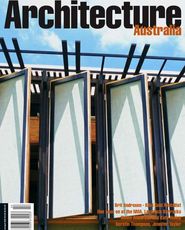Review
Conventional wisdom
In many ways, architecture can be understood as the first market to go global - even before finance. Historically, architectural ideas have been inevitably linked to social and technological developments which are, generally, international phenomena. Architects travelled the world looking for clients who desired their talent and the ideas that their architecture championed. Cities were the place of new ideas, innovation and social discussion. Today our cities are more comfortable with multinational companies and their high-rise accommodation (referring to a city’s profit, leverage and place in the world economy) than with public interest and accountability. As a result, the same building can, literally, be found in Melbourne, Perth or Denver as copybook designs proliferate due to a successful cost analysis.
Putting the microscope on architectural practice, and the circumstances in which practice now operates, is this year’s grands projet. Local practice workshops run by the chapters, and a global practice forum in Sydney, provide the leadup to Global:Local, the joint Designbuild/RAIA Convention, to be staged in Melbourne from 2-5 June 2002. This event should prove to be significant and challenging. In addition to the program, convention delegates will gain access to a host of new buildings including Federation Square (one week before its opening).
Architect actors ›› The debate over the little-known Architects Acts was a litmus test of the issues that lie hidden beneath Australia’s rapid urbanisation. The test was poignant and timely. At the invitation of the Federal Government, state governments were required to take a stance on whether the built environment is just another commodity in the free enterprise arena, or whether built “products” have a significantly different political and public interest dimension.
Proponents of freer markets and unregulated building design made their mark with the November 2000 Productivity Commission Report. This recommended repealing all Architects Acts, with no proposed replacement. One economic argument underlying the suggested repeals was that consumer markets may suffer a cost penalty by inadvertently relying on the advice of a person more qualified than they actually require for the task. The economic message was clear, consumers have a right to be narrow and effectively selfish and they must also, simultaneously, evaluate and even commercialise their own risk.
Architects, however, can demonstrate their desire to serve the general public interest as well as their client’s specific interest. Architects Acts, or their equivalent, can be used to directly promote and indirectly protect public interest through the instigation of a risk management regime. The RAIA has a played a major and fundamental role in ensuring that state and territory governments have responded appropriately.
Architects cannot expect to have unfettered freedom, but nor can developers. The purpose of an Architects Act, or its equivalent, is to allow a government to define a responsible skill level for building designers, to inspire them to engage with the public, and to discipline them if they fail to protect the public interest. The purpose of government regulations is to identify the boundaries of development in our cities in order to prevent the wholesale commercialisation of the built environment. For the architect, a well defined regulation is a form of risk management. It can allow the architect to declare, under law, that certain duties must be undertaken or completed, and that the business practices of commercialising risks, avoiding responsibility, or transferring liability are not an option. The responsibility of the public is to acknowledge the role they play at all levels of the process - as client, resident, neighbour or protester - and to demand better environments in which to live.
Graham Jahn FRAIA
RAIA National President















